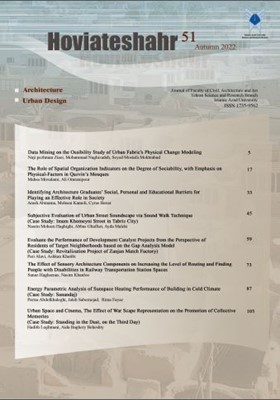Evaluate the performance of development catalyst projects from the perspective of residents of target neighborhoods based on the Gap analysis model (Case Study: Revitalization Project of Zanjan Match Factory)
Subject Areas : urban planning
Pari Alavi
1
*
![]() ,
Ashkan khatibi
2
,
Ashkan khatibi
2
1 - Ph. D, Department of Architecture, Zanjan branch, Islamic Azad University, Zanjan, Iran
2 - Ph. D, Department of Architecture, Zanjan branch, Islamic Azad University, Zanjan, Iran
Keywords: Regeneration, Project, Zanjan Match Factory, Perceptions and Expectations, Development catalyst, Gap analysis,
Abstract :
When a project for the development of the city is planned, designed and implemented, it will definitely have consequences. Development catalyst projects are no exception to this rule. In recent years, with the increase of these projects, It is necessary to study the views of citizens of the neighborhoods targeted for regeneration as the main stakeholders of these projects. The current study aims to determine the effectiveness of the match factory revitalization project in improving the quality of the neighborhood to measure the perceptions and expectations of neighborhood residents of the dimensions and factors of local development and catalyst. This research is of applied type and has been prepared by evaluation method with gap analysis model, and its statistical population consists of residents and businesses over 18 years of age in the Koochamshki neighborhood. The sample size was determined using Cochran's formula and simple random method, 384 people. The required information was collected through library and survey studies using a questionnaire and analyzed using ANOVA and T-Test. The results indicate a high score of respondents 'expectations from the three dimensions of development and catalyst (4.23) and a low score of their perception (3.26), which shows that there is a difference between residents' perceptions and expectations after the revival of the match factory. Also, the existence of a significant gap (-0.97) between residents' perceptions and expectations of the dimensions and factors of development and catalyst in this neighborhood confirms the second hypothesis of the research. Calculating the difference between the average score of residents' perceptions and expectations among the factors also shows that the largest gap belongs to the factor of "residential dignity" (-1.48) and the lowest gap belongs to the factor of "physical and environmental status of housing" (-0.4). dedicated. The findings also indicate that there is a significant difference between the expectations and perceptions of respondents in terms of their residency, but in relation to the gender of respondents, despite the gap between the views of both sexes, no significant difference in terms of perception and expectation was found between men and women. An important issue in findings is the negative gap in all dimensions and factors studied which shows the failure of planners to meet residents' expectations of changes effected by the catalyst project. Observations and field studies show that after the implementation of this project, growing events have taken place in this neighborhood; But analytical studies indicate that the implementation of this project has not yet been able to meet the demands and needs of neighborhood residents. The research findings indicate the existence of a gap between residents' perceptions and expectations of development factors in this neighborhood, which is statistically significant. An important issue in the research findings is the negative gap in all dimensions and factors studied, which shows the failure of planners to meet residents' expectations of changes effected by the local development catalyst project. In order to increase the residents' satisfaction, the factors with more gaps should be prioritized and measures should be taken to reduce the desired gap.
_||_

